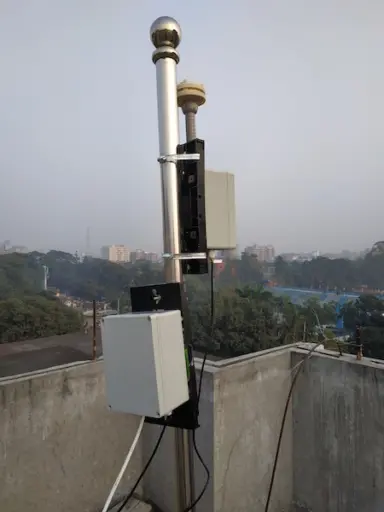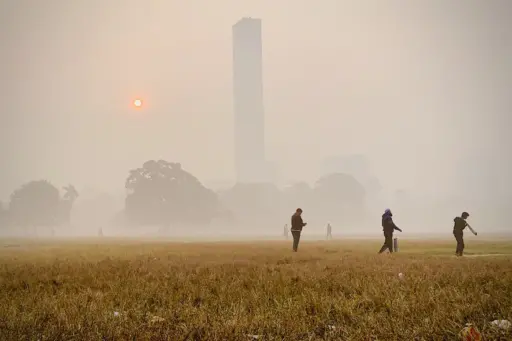Bangladesh and its neighboring areas routinely suffer from some of the poorest air quality on the planet.
 James Schauer
James Schauer
Through his work, James Schauer aims to make a dent in that pollution.
A professor of civil and environmental engineering at the University of Wisconsin-Madison, Schauer is leading an effort to bolster air monitoring capabilities in the region and encourage the governments of Bangladesh and India to cooperate in fighting air pollution. He is working with Wisconsin State Laboratory of Hygiene Senior Scientist Ross Edwards on a project to install 30 internet-linked air quality monitoring stations in Kolkata, in India’s West Bengal region, and around Bangladesh’s capital city of Dhaka.
Schauer is a world expert on air quality, and currently is director of the Wisconsin State Laboratory of Hygiene at UW-Madison. He has extensive research experience investigating air pollution in more than 30 countries around the world over the past 20 years.
The three-year project is funded via an approximately $350,000 grant from the U.S. State Department. The team will build medium-cost sensors from commercial and UW-Madison designed components and test them in Madison and Milwaukee. Edwards says they have two prototypes already deployed, but hope to have both networks fully deployed by summer 2020. The sensor networks consist of 15 sensor nodes in both Kolkata and Dhaka. Data from the sensors will be accessible from anywhere in the world.
 Ross Edwards
Ross Edwards
“There is an initiative to put U.S. Environmental Protection Agency regulatory monitors in every embassy and consulate where there are air pollution problems,” Schauer says. “However, the regulatory monitors are in just one site, so you don’t provide spatial information on pollutant concentrations. The regulatory monitors are pretty expensive. We’ve built these medium-cost sensors and we’re co-locating one at the embassies and consulates, then deploying the rest around metropolitan region so we can have quality data that is spatially resolved.”
Beyond improving the public availability of air pollution data, Schauer says an aim of the project—and his work throughout the region—is to encourage nations to work together on improving air quality. Schauer and Edwards will collaborate with local stakeholders, such as policymakers and academic institutions, to engage them in combating the air quality crisis.
“Air pollution is clearly a trans-boundary problem, but most citizens and countries do not approach air pollution from a regional cooperation perspective,” he says. “A lot of research has been conducted to address trans-boundary air pollution, so we are hoping that the project will be a catalyst to move that forward with regional cooperation on air quality. Part of my role with the State Department is what is often called science diplomacy. We are using scientific cooperation to open channels for diplomatic interactions.”
A critical air pollutant that is the dominant concern for health in many parts of the world in the PM2.5 concentration, a metric that measures the particulate matter in the air that is smaller than 2.5 microns in diameter.
 A team of engineers is working to build moderate-cost air quality sensors like the one pictured, located at Dhaka University.
A team of engineers is working to build moderate-cost air quality sensors like the one pictured, located at Dhaka University.
According to data from monitoring stations in the region, air quality around Dhaka and Kolkata frequently is unhealthy according to US and World Health Organization (WHO) standards. A report issued by IQ Air Quality found that, in 2018, Dhaka had the second-worst average air quality of any city in the world after Delhi, India, and Bangladesh had the worst average air quality of any country.
Schauer says the poor air quality arises from a variety of factors at play across the region, combined with a lack of strong regulatory control on air pollution sources.
“In these cities, just like other major cities around the world, air pollution sources like vehicles and power generation are very important,” Schauer says. “Re-suspended dust from roads and construction is also a contributor to PM2.5. In parts of the South Asia, where people don’t have access to clean energy, they burn solid fuels like cow dung. There’s also important air pollution sources in these cities including industry and power generation. The US has done a a good job in installing air pollution controls controls on these sources in the United States, but these controls technologies have not been widely deployed in these cities.
Edwards notes that, at certain times of year, seasonal winds die down and air lingers over the region. Conditions tend to improve in the summer, when rains help clear pollutants from the sky.
“At times, there is zero wind,” Edwards says. “With that many people in such a small area, with all the vehicles and rubbish burning and cooking—all of that stuff is like smoking into a bottle.”
 Thick pollution hangs in the air around Kolkota, India.
Thick pollution hangs in the air around Kolkota, India.
The severity of the region’s air pollution has dire implications for hundreds of millions of people. Bangladesh, with an area of about 57,000 square miles, is slightly smaller than Wisconsin’s 65,500 square miles. However, the country has more than 25 times the population, with about 165 million residents, compared to the Badger State’s 5.8 million people.
“The greater urban area has about 30 million people, between the two cities,” Edwards says. “That’s about the same as the population of Australia and New Zealand combined. Bangladesh has the highest population density on Earth in some parts, reaching more than 40,000 people in about a third of a square mile. It’s hard to wrap your head around it, and they have some incredible air pollution problems, especially around this time of year.”
In 2019, United Nations Special Rapporteur on Human Rights and the Environment David Boyd called air pollution a “silent, sometimes invisible, prolific killer,” that is responsible for the premature deaths of more than seven million people every year around the world.
“Exposure to air pollution tends to make all of the diseases we have worse,” Schauer says. “It increases risks of childhood asthma, heart attacks and respiratory disease and a wide range of human diseases. It’s really hard to identify individual people as dying from air pollution, but the prevalence of mortality has been documented to increase with higher to exposure to air pollution for many human diseases with epidemiological studies. Air pollution is an important contributor to excess mortality and morbidity around the world.”